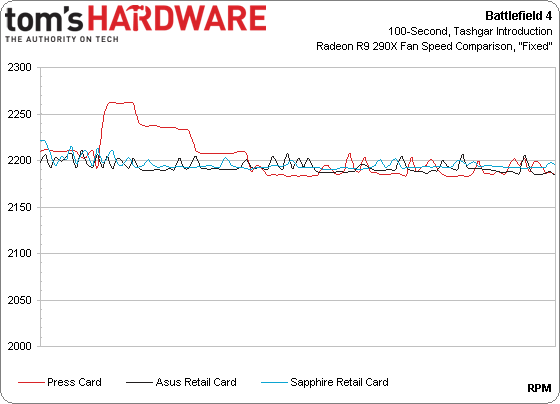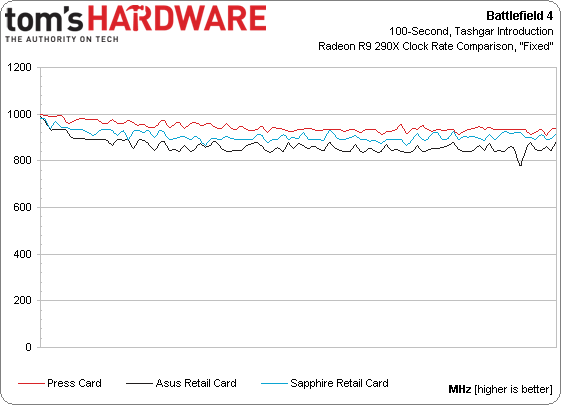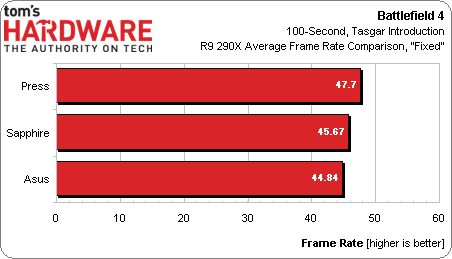The Cause Of And Fix For Radeon R9 290X And 290 Inconsistency
We first observed differences between the Radeon R9 290X cards that AMD sent out for review and the ones being sold online just before our R9 290 coverage went live. After additional testing, we have answers, feedback from AMD, and more questions.
AMD’s Solution Surfaces
Shortly after AMD Radeon R9 290 Review: Fast And $400, But Is It Consistent? went live, AMD issued the following note to media:
“A media outlet has uniquely reported instances of AMD Radeon R9 290X boards purchased in retail that have exhibited an uncharacteristic level of performance variance as compared to press samples issued by AMD. We’re working to secure the board(s) in question for further analysis. Boards purchased by other media outlets have not exhibited similar characteristics that we’re aware of. In the meantime, we’ve identified areas where variability can be minimized and are working on a driver update which will minimize this variance. We will provide an update shortly.”
The official explanation for the numbers we reported in our R9 290X and GeForce GTX 780 Ti reviews is that Radeon R9 290X uses PWM to control fan speed. The fan it uses purportedly has a +/-300 RPM margin. So, 40% does not necessarily mean the same rotational speed on every card. But AMD claims it was not prepared to see variance as severe as what we saw. Company representatives say R9 290X should be spinning at 2200 RPM (although we've seen no evidence of any 290X at 2200 RPM/40%). Already, that puts Asus’ board beyond the fan’s specification at 1850 RPM.
Here in Bakersfield, CA, it still gets fairly warm during the day. I have to keep a thermal probe in the lab to ensure consistent-enough temperatures for testing. As I was taking measurements for this piece, I was seeing between 78 and 80 degrees Fahrenheit. One morning, I walked into the office and it was closer to 74 before benchmarking commenced. At that temperature, Sapphire's Radeon R9 290X behaved almost as well as AMD's press card in a 78- to 80-degree room. The reference thermal solution is operating very close to its limit, making R9 290X very sensitive to environmental changes. That's just one of those things you have to consider when you buy a card with such a wide operating range. Relief is only going to come in the form of more effective cooling from partners.
Now, all of this was to describe what we were seeing up until today (and what other outlets were commenting on). Hours ago, though, AMD issued this follow-up:
We’ve identified that there’s variability in fan speeds across AMD R9 290 series boards. This variability in fan speed translates into variability of the cooling capacity of the fan-sink.The flexibility of AMD PowerTune technology enables us to correct this variability in a driver update. This update will normalize the fan RPMs to the correct values.The correct target RPM values are 2200 RPM for the AMD Radeon R9 290X ‘Quiet mode’, and 2650 RPM for the R9 290. You can verify these in GPU-Z.
Roughly translated, this means that retail and press cards are being altered via software to operate at the same rotational speed under load. This would be a great thing if AMD was standardizing on the press card's fan, since that's the board we reviewed and praised. However, it's using this opportunity to put an additional 150 RPM through the 290X's fan, presumably to sustain higher clock rates for longer, improving performance. The side effect, of course, is higher power consumption and increased noise.
Get Tom's Hardware's best news and in-depth reviews, straight to your inbox.
So, let's get Catalyst 13.11 Beta 9.2 installed and try again:
With the exception of the press card shooting up about 60 RPM for no clear reason, AMD's new driver successfully gets all three cards running around 2200 RPM. I don't have the same mic setup as Igor here in my lab, so I can't give you a good noise comparison. However, the card is noticeably louder than it was at 2050 RPM.
Clock rates are higher across the board, as you'd expect after increasing cooling capacity. AMD's own press board now averages 944 MHz, up from 917 MHz. Asus' troubled retail card settles at 863 MHz. Meanwhile, Sapphire crests 906 MHz in our test, on average.
Frame rates improve, too. The 11% variability we saw previously is down to 6%. That's great news. Remember that we're still dealing with the same reference cooler though...and it's getting louder. Fan speed as a percentage creeps up as high as 46% in the case of Asus' card, turning Quiet mode into Not Quite Quiet mode.
AMD is basically doing two things. First, it's fixing an issue that should have never made it past quality control and tightening up the variance between Radeon R9 290X cards in the wild. Simultaneously, it's pushing average clock rates of all cards higher using a faster fan speed setting that no board we've seen used previously. Our Battlefield 4 benchmark illustrates this nicely. By default, 190 MHz separated the average core frequencies of our fastest and slowest samples. After AMD's newest driver build, that number shrinks to 81 MHz.
Current page: AMD’s Solution Surfaces
Prev Page Can We Fix The Variance Ourselves? Next Page Radeon R9 290 Gets The Same Treatment-
tttttc I never understand why ANYONE will buy the reference design cards.... even for the GTX780, the aftermarket cooler is way better and quieter than the stock fan.Reply -
eldragon0 Thank you so much for this article, I've been waiting on a write-up of this sort. There is one thing I'd love to see. Assuming the 290 and the 290x have the same layout, is it possible for you to strap that aftermarket heatsink onto each of them and give us a comparison of both of them at retail without them being horribly throttled? I'd love nothing more than to see a 290 and a 290x head to head at full speeds !Reply -
itzsnypah Reply11889637 said:This kind of thing is why I use msi afterburner. Just set your own fan curve.
That is not how powertune works.
It's: Get Hot -> Get loud -> Drop clocks -> Get as loud as necessary to keep GPU from melting.
So having a 'custom' fan curve does nigh nothing.
E: I wonder what would happen if you fed the card hot air. What happens when you're at 100% fan speed and still pushing 96c+? Does it shut down, clock down even more or melt? -
FormatC Replyis it possible for you to strap that aftermarket heatsink onto each of them
It is impossible. The reason is simple: thermal clue. As I wrote in my article about the thermal grease: after the burn-in it is nearly impossible to remove the small heatsinks. The risk to destroy the card is too high. This aftermarket cooler is good and quiet but it is a real one-way ticket. You can't return ;)
For addition - I've done the same thing with R9 290 cards and another benchmark before AMD has changed the driver. We worked hard to detect the reason for this big variances. But it seems that the difference between the R9 290 cards is a little bit smaller.
This was before:
-
Quaddro Praise this card..Reply
Now we can see 780Ti and 780 with more reasonable price..;)
Still waiting msi hawk version or directCu version of both of this card..hope that series will handle the heat..
Spend $100 more just for cooler (mk-26 + 2 fans) on reference card, is not a really good option.. -
Nintendo Maniac 64 I wonder if the rest of the performance difference now boils down to how the stock thermal paste was applied.Reply -
FormatC This I've tested too. No mentionable differences. May be my cards were assembled by a very accurate robot ;)Reply
The voltage is a little bit different:
But this is not strange. Typical tolerance. -
iam2thecrowe I cant stand all this variable clock rate BS ever since it was introduced in nvidia and amd cards. the card throttles in the most demanding scenario's, where you need it not to throttle, so the "boost clock" speeds are just there to inflate benchmark figures without any improvement in real world performance. On my cards, i force a stable clock speed with Nvidia inspector, negating boost clock, games run more stable and predictably, the way it should be.Reply
p.s. the add for nail fungus you have on your page toms, nearly made me vomit. please no more nail fungus adds!!!!!!!



